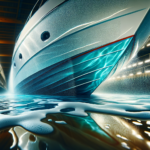Navigating through areas with heavy boat traffic can be a nerve-wracking experience, especially for novice boaters. However, adopting the best practices can help ensure a safe and smooth journey. In this article, we will explore some valuable tips and strategies for handling and navigating in such busy waterways. We will discuss the importance of maintaining a proper lookout, understanding and adhering to the right-of-way rules, practicing good communication, and using navigational aids effectively. By following these guidelines, you can confidently navigate through areas bustling with boat activities and enjoy your time on the water without any unnecessary stress or mishaps.
Understanding Boat Traffic
When it comes to handling and navigating in areas with heavy boat traffic, it’s crucial to have a good understanding of the dynamics of boat traffic. Identifying high-traffic areas is the first step in this process. These areas are typically marked by an increased number of vessels, such as busy marinas, popular fishing spots, or major waterways near cities or tourist destinations.
Understanding the patterns of boat traffic is also essential. Take note of the times when boat traffic is at its peak, such as weekends, holidays, or specific events. By being aware of these patterns, you can plan your trip accordingly and anticipate congested areas or increased activity.
Recognizing the common types of vessels you may encounter is another aspect of understanding boat traffic. Different types of boats have different characteristics and maneuverability, which can affect how they navigate through crowded waters. Familiarize yourself with sailboats, powerboats, fishing boats, and any other types of vessels commonly found in your area.
Preparation and Planning
Before heading out into areas with heavy boat traffic, proper preparation and planning are vital. One essential aspect is checking the weather and conditions. Stay updated on the forecast, paying attention to factors like wind speed and direction, wave heights, and visibility. This information will help you decide whether it’s safe to navigate in heavy boat traffic or if it’s best to wait for more favorable conditions.
Obtaining nautical charts and maps is another crucial step in preparation. These resources provide valuable information such as water depths, navigational aids, submerged hazards, and restricted areas. Familiarize yourself with the charts and maps relevant to the specific area you’ll be navigating to ensure a safe and efficient journey.
Identifying navigational aids is essential for maintaining a clear and safe route. These aids can include buoys, beacons, lighthouses, and other markers that guide mariners through channels and indicate potential hazards. Understanding how to interpret and follow these aids will help you navigate through areas with heavy boat traffic more effectively.
Proper Communication and Awareness
Clear and effective communication is key to navigating in areas with heavy boat traffic. Using marine radio channels is an essential part of maritime communication. Familiarize yourself with the appropriate channels and protocols for your area, and ensure your radio is in good working condition before setting off. This communication tool allows you to communicate with other boaters, bridge operators, or emergency services if needed.
Maintaining eye contact with other boaters is another crucial aspect of communication and awareness. By making eye contact, you can establish a visual connection and better anticipate the intentions of other vessels. This practice is particularly important when crossing paths, entering or exiting narrow channels, or maneuvering through congested areas.
In addition to eye contact, using hand signals can further enhance communication on the water. Simple gestures, such as pointing in a certain direction, indicating a change in speed, or signaling a turn, can help convey your intentions to other boaters. Familiarize yourself with commonly used hand signals and utilize them when necessary.
Maintaining Safe Speeds
Maintaining safe speeds is of utmost importance when navigating in areas with heavy boat traffic. Understanding speed limits is essential, as different areas may have specific regulations regarding vessel speed. Respect the posted speed limits and adjust your speed accordingly to ensure the safety of yourself and others around you.
However, adjusting your speed according to conditions is equally important. Factors such as visibility, wave conditions, and the presence of other vessels may require you to slow down even if you are within the legal speed limits. Be prepared to reduce your speed or come to a complete stop if necessary to avoid collisions or hazards.
Being mindful of wave effects is another aspect of maintaining safe speeds. The wake created by your vessel can affect other boats, particularly smaller ones or those moored nearby. Reduce your speed in areas with significant boat traffic to minimize the potential negative impact of your wake on other boaters and their vessels.
Maintaining Distance and Right of Way
When navigating in areas with heavy boat traffic, maintaining an appropriate distance from other vessels is crucial. Avoid getting too close to other boats, as this can increase the risk of collisions, especially in congested areas. Leave ample space between your vessel and others, and be cautious of the potential sudden changes in direction or speed of nearby boats.
Understanding the concept of right-of-way is essential for safe navigation. Different types of vessels have specific right-of-way rules, and it’s crucial to familiarize yourself with these rules to avoid conflicts on the water. Give way to larger vessels, sailboats, and vessels constrained by their draft or maneuverability. By understanding and respecting right-of-way rules, you can navigate through heavy boat traffic more safely and efficiently.
Additionally, be aware of the effects of wake caused by passing boats. The wake generated by larger boats can be significant and can cause smaller vessels to become unstable or take on water. Be considerate of the impact your wake may have on other boaters and adjust your speed or course if necessary to minimize the effects of your wake.
Navigating Busy Channels and Crowded Areas
Navigating through busy channels and crowded areas requires careful attention to detail. Identifying and following channel markers is crucial in these situations. Channel markers provide a clear and defined route through congested areas, indicating the deepest and safest path for navigation. Be vigilant in identifying and obeying these markers to ensure you stay on the correct course.
Be aware of blind spots when navigating in congested areas. Larger vessels may have restricted visibility, especially in their bow or stern areas. Stay clear of these blind spots, and avoid lingering in areas where larger boats may have difficulty seeing you. By maintaining awareness of potential blind spots, you can reduce the risk of collisions with larger boats.
Navigating through congested areas requires a high level of situational awareness. Pay close attention to the movement of other boats, be prepared for sudden changes in direction or speed, and anticipate potential hazards or bottlenecks. By navigating with caution and staying alert, you can safely maneuver through busy channels and crowded areas.
Anticipating and Reacting to Hazards
Hazards can present themselves in various forms on the water, and it is essential to be able to anticipate and react accordingly. Spotting stationary and moving hazards is crucial for avoiding collisions or damage to your vessel. Keep a lookout for objects such as logs, buoys, rocks, or other vessels that may pose a threat to safe navigation.
Preparing for sudden changes in direction is important when navigating in areas with heavy boat traffic. Boaters may unexpectedly change course or maneuver in congested waters, creating unpredictable situations. Stay attentive and ready to react quickly to avoid any potential collisions or accidents. Be prepared to adjust your speed or direction to maintain a safe distance from other boats.
Reacting to unexpected maneuvers by other boaters is equally important. Stay calm and be prepared to adjust your course or speed to avoid potential collisions. Communication, both verbal and non-verbal, is vital in these situations. Using your marine radio channels or hand signals to indicate your intentions and maintain clear communication can help prevent accidents or misunderstandings.
Being Mindful of Others
When navigating in areas with heavy boat traffic, it’s essential to be mindful of others on the water. Excessive noise or wake from your vessel can disturb other boaters or damage nearby structures. Keep noise levels to a minimum, particularly in residential or marina areas, and reduce your speed to minimize the wake created by your vessel.
Allowing ample space for other vessels is another way to show respect and consideration. Avoid traveling too closely behind or alongside other boats, giving them enough room to maneuver safely. Keep in mind that different types of vessels require different amounts of space to navigate effectively, so be aware of their specific needs and give them the necessary room.
Being respectful and considerate of other boaters is a fundamental principle of safe navigation. Treat fellow boaters with kindness and courtesy, and adhere to the “golden rule” of boating: do unto others as you would have them do unto you. By practicing good etiquette on the water, you contribute to a positive and safe boating environment for everyone.
Navigating in Low Visibility Conditions
Navigating in low visibility conditions can present significant challenges, and it requires additional precautions to ensure safe navigation. Using proper lighting and signals is crucial for making your vessel visible to others. Ensure that your navigation lights are functioning correctly and use them according to the specific requirements for your vessel’s size and type. Consider using additional lighting, such as a spotlight, to increase your visibility in foggy or dark conditions.
Relying on radar and other navigation aids can provide valuable assistance in low visibility conditions. Radar allows you to detect the presence of other vessels, even when they are not visible to the naked eye. Familiarize yourself with the operation of your radar system and learn how to interpret the radar image effectively. Additionally, use other navigation aids such as GPS or electronic chart plotters to help maintain your intended course and avoid potential hazards.
Implementing sound signals is another method of communication in low visibility conditions. Boats are required to sound horn signals in various situations, such as when encountering other vessels in restricted visibility or when approaching blind corners. Understand the different sound signals and utilize them when necessary to inform other boaters of your presence and intentions.
Best Practices for Anchoring
Anchoring is often necessary when navigating in areas with heavy boat traffic, and following best practices is essential for a safe and successful anchoring experience. Choosing appropriate anchoring spots is crucial to ensure the stability and security of your vessel. Look for protected areas with sufficient depth and good holding ground, away from channels or areas with heavy boat traffic.
Using proper equipment and techniques is equally important. Make sure you have an anchor suitable for the type of seabed you will be anchoring on. The anchor should have enough holding power to keep your vessel secure. Familiarize yourself with the correct way to deploy and retrieve your anchor, ensuring it is properly set and securely holding your vessel before leaving it unattended.
Maintaining awareness of your surroundings is essential while anchored in areas with heavy boat traffic. Be mindful of nearby vessels, other boats maneuvering near your anchored position, and potential hazards such as underwater obstructions. Regularly monitor your position and be prepared to re-anchor if necessary to maintain a safe distance from other boats or avoid dangerous situations.
In conclusion, navigating in areas with heavy boat traffic requires a combination of knowledge, preparation, and good communication skills. By understanding boat traffic patterns, preparing adequately, maintaining safe speeds and distances, and being considerate of others, you can navigate through congested waters safely and enjoy your boating experience to the fullest. Remember to always stay vigilant, respect the rules of the waterways, and prioritize the safety of yourself and others. Happy boating!





